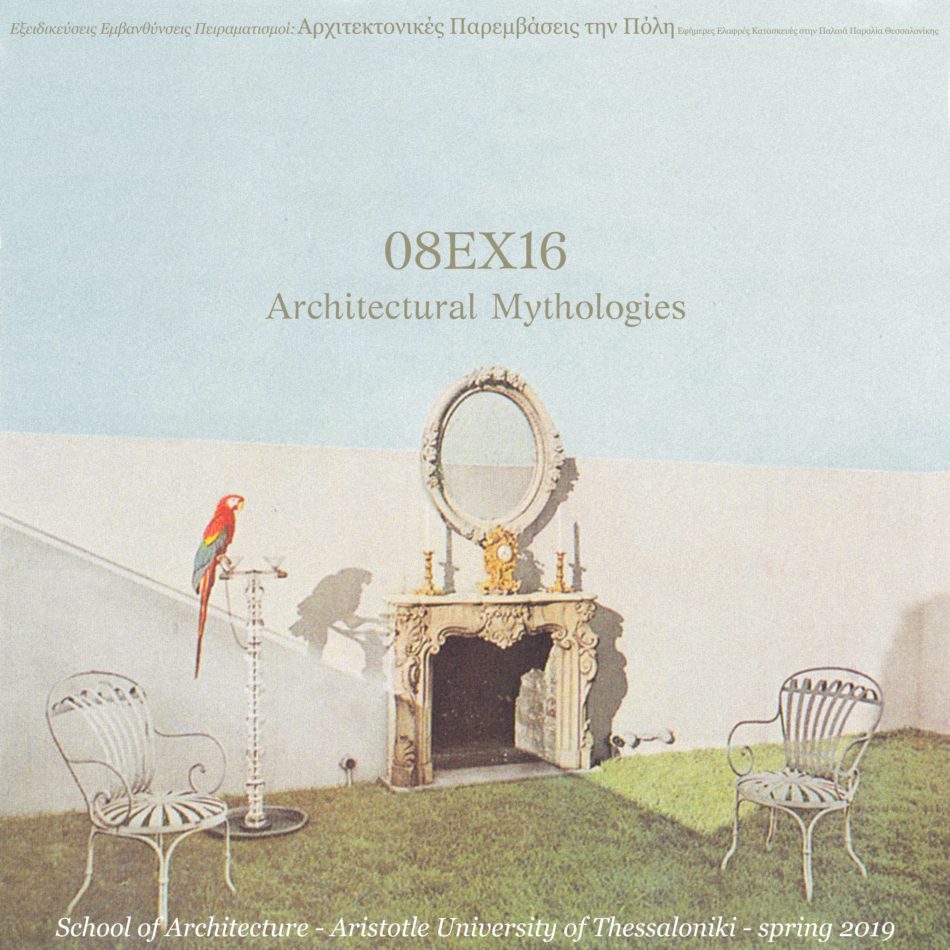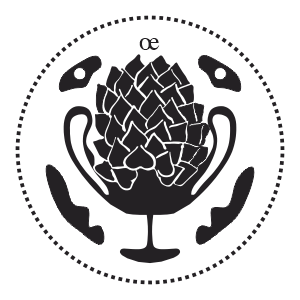Architectural Mythologies:
[bk_tabs]
[bk_tab title=”EN”]
The design studio will explore the ways in which architecture can incorporate into its processes elements that have been replaced by the rationalized understanding of technology. An understanding that have been imposed by modernity throughout the 20th century and with even greater strength after the advent of digital tools well into the beginning of the 21st.
In the context of the studio students will seek through design new possible conditions for the meeting points of the collapsing traditional juxtapositions. In other words the students will learn to deal with design within the current conditions where all certainties are falling apart: all convictions about what is architectural and what not, what is urban and what is landscape, what is natural and what artificial, what is history and what innovation, are long gone. In their undoing, the need for new architectural and urban myths arises: the students therefore will ultimately be creating architectural myths, embracing the danger that such a process entails.
The studio will use as a case study the architectural follies; as a design vehicle references – architectural or not; as a tool for their modulation technology (or the lack thereof); as a field the city of Thessaloniki and its relation to water; and as a starting point the concept of the island. The aim is to construct architectural narratives / mythologies that could make architecture dangerous again.
In the context of the studio students will seek through design new possible conditions for the meeting points of the collapsing traditional juxtapositions. In other words the students will learn to deal with design within the current conditions where all certainties are falling apart: all convictions about what is architectural and what not, what is urban and what is landscape, what is natural and what artificial, what is history and what innovation, are long gone. In their undoing, the need for new architectural and urban myths arises: the students therefore will ultimately be creating architectural myths, embracing the danger that such a process entails.
The studio will use as a case study the architectural follies; as a design vehicle references – architectural or not; as a tool for their modulation technology (or the lack thereof); as a field the city of Thessaloniki and its relation to water; and as a starting point the concept of the island. The aim is to construct architectural narratives / mythologies that could make architecture dangerous again.
[/bk_tab]
[bk_tab title=”GR”]
Το εργαστήριο σχεδιασμού θα διερευνήσει τους τρόπους με τους οποίους η αρχιτεκτονική μπορεί να (ξανα)ενσωματώσει στις διαδικασίες της στοιχεία που εκτόπισε η εκλογικευμένη προσέγγισης της τεχνολογίας καθ’ όλη τη διάρκεια του 20ου αιώνα και, με ακόμα μεγαλύτερη ένταση μετά την έλευση των ψηφιακών μέσων, στις αρχές του 21ου: το μαγικό, το μη λογικό, τη βαρβαρότητα.
Στα πλαίσια του μαθήματος, οι φοιτητές θα αναζητήσουν με αρχιτεκτονικούς όρος, δηλαδή μέσω του σχεδιασμού, πιθανές νέες συνθήκες για το σημείο συνάντησης μεταξύ των παραδοσιακών διπόλων που καταρρέουν. Με άλλα λόγια, οι φοιτητές θα σχεδιάσουν μαθαίνοντας να αντιμετωπίζουν τον σχεδιασμό μέσα στις νέες συνθήκες από τις οποίες αναδύεται μία πολύπλοκη κατάσταση όπου οι βεβαιότητες για το τι συνιστά αρχιτεκτονικό χώρο και τι όχι, για το τι είναι αστικός χώρος και τι είναι τοπίο, για το τι είναι φυσικό και τι τεχνητό και για το τι είναι ιστορικό και τι καινοτόμο έχουν χαθεί. Μέσα από αυτή την καταστροφή των βεβαιοτήτων προκύπτει η ανάγκη για νέους αρχιτεκτονικούς μύθους: οι φοιτητές επομένως θα κληθούν να δημιουργήσουν νέες αρχιτεκτονικές μυθολογίες, αγκαλιάζοντας τους κινδύνους που εμπεριέχει μία τέτοια προσπάθεια.
Το εργαστήριο θα χρησιμοποιήσει ως παράδειγμα τα αρχιτεκτονικά follies, ως όχημα σχεδιασμού τις – αρχιτεκτονικές και μη – αναφορές, ως εργαλείο αλλοίωσής τους την τεχνολογία (ή την άρνησή της), ως πεδίο την πόλη της Θεσσαλονίκης και τη σχέση της με το στοιχείο του νερού, και ως εναρκτήρια ιδέα αυτή του ‘νησιού’. Ο στόχος η δημιουργία αρχιτεκτονικών αφηγήσεων / μυθολογιών που θα μπορέσουν να καταστήσουν την αρχιτεκτονική (ξανά) επικίνδυνη.
Διδάσκων: Δημήτρης Γουρδούκης
Στα πλαίσια του μαθήματος, οι φοιτητές θα αναζητήσουν με αρχιτεκτονικούς όρος, δηλαδή μέσω του σχεδιασμού, πιθανές νέες συνθήκες για το σημείο συνάντησης μεταξύ των παραδοσιακών διπόλων που καταρρέουν. Με άλλα λόγια, οι φοιτητές θα σχεδιάσουν μαθαίνοντας να αντιμετωπίζουν τον σχεδιασμό μέσα στις νέες συνθήκες από τις οποίες αναδύεται μία πολύπλοκη κατάσταση όπου οι βεβαιότητες για το τι συνιστά αρχιτεκτονικό χώρο και τι όχι, για το τι είναι αστικός χώρος και τι είναι τοπίο, για το τι είναι φυσικό και τι τεχνητό και για το τι είναι ιστορικό και τι καινοτόμο έχουν χαθεί. Μέσα από αυτή την καταστροφή των βεβαιοτήτων προκύπτει η ανάγκη για νέους αρχιτεκτονικούς μύθους: οι φοιτητές επομένως θα κληθούν να δημιουργήσουν νέες αρχιτεκτονικές μυθολογίες, αγκαλιάζοντας τους κινδύνους που εμπεριέχει μία τέτοια προσπάθεια.
Το εργαστήριο θα χρησιμοποιήσει ως παράδειγμα τα αρχιτεκτονικά follies, ως όχημα σχεδιασμού τις – αρχιτεκτονικές και μη – αναφορές, ως εργαλείο αλλοίωσής τους την τεχνολογία (ή την άρνησή της), ως πεδίο την πόλη της Θεσσαλονίκης και τη σχέση της με το στοιχείο του νερού, και ως εναρκτήρια ιδέα αυτή του ‘νησιού’. Ο στόχος η δημιουργία αρχιτεκτονικών αφηγήσεων / μυθολογιών που θα μπορέσουν να καταστήσουν την αρχιτεκτονική (ξανά) επικίνδυνη.
Διδάσκων: Δημήτρης Γουρδούκης
[/bk_tab]
[/bk_tabs]https://architecturalmythologies.tumblr.com
_

_
Theories of Architecture:
_
[bk_tabs]
[bk_tab title=”EN”]
During the last 20 years the ways and methods of architectural production went through a process of transformation and change – a result of the new media – that maybe can be compared to similar transformational processes that took place during the Renaissance – where, again, it was technological innovations, like the use of paper and pencil, the invention of projective geometry and the perspective, that set the wheel of change in motion. Of course, that transformation is not something exclusive to architecture. On the contrary, it is the reflection of the broader conditions of contemporary societies: The dominance of networks and the omnipresent connectivity, a condition where new modes of control, and therefore power, are being established.
It is within this new condition that architecture students and future architects need to operate in order to be able to bring a breath of fresh air in the body of the creative process. The course therefore, offers the necessary theoretical tools that will aid the students to understand that condition, based on the principle that the evolution of architectural thinking is a continuum where ideas are constantly modulated and the new is the result of the mutations of the old. Therefore, the key for an understanding of the current condition in architecture lies in the understanding of the evolution of architectural thinking during modernity – starting from the Renaissance and reaching the present day – and more importantly, in the understanding of the connections between points in time and periods that might appear unconnected on the surface. The approach of the course, while following a loose chronological order that begins with Alberti, is in fact, not a historical approach. On the contrary, it deals with the points of this continuum as events that in many cases transcend temporal succession and create connections that ignore linear time. Ultimate goal of the course is to provide the students with the necessary framework that will help them understand the different instances of the theory of architecture and their principles, but maybe more importantly, will help them expand and enrich their design processes.
It is within this new condition that architecture students and future architects need to operate in order to be able to bring a breath of fresh air in the body of the creative process. The course therefore, offers the necessary theoretical tools that will aid the students to understand that condition, based on the principle that the evolution of architectural thinking is a continuum where ideas are constantly modulated and the new is the result of the mutations of the old. Therefore, the key for an understanding of the current condition in architecture lies in the understanding of the evolution of architectural thinking during modernity – starting from the Renaissance and reaching the present day – and more importantly, in the understanding of the connections between points in time and periods that might appear unconnected on the surface. The approach of the course, while following a loose chronological order that begins with Alberti, is in fact, not a historical approach. On the contrary, it deals with the points of this continuum as events that in many cases transcend temporal succession and create connections that ignore linear time. Ultimate goal of the course is to provide the students with the necessary framework that will help them understand the different instances of the theory of architecture and their principles, but maybe more importantly, will help them expand and enrich their design processes.
[/bk_tab]
[bk_tab title=”GR”]
Κατά τη διάρκεια των τελευταίων 20 χρόνων οι τρόποι και οι μέθοδοι αρχιτεκτονικής δημιουργίας πέρασαν μέσα από μία ιδιαίτερη διαδικασία μετάλλαξης και αλλαγής – αποτέλεσμα των νέων μέσων – που θα μπορούσε ίσως να συγκριθεί με τις αντίστοιχες διαδικασίες μετάλλαξης που συντελέστηκαν κατά τη διάρκεια της αναγέννησης – όπου και πάλι ήταν τεχνολογικά επιτεύγματα που έκαναν αυτή τη μετάβαση δυνατή, π.χ. η γενίκευση της χρήσης χαρτιού και μολυβιού, η εφεύρεση της προβολικής γεωμετρίας και της προοπτικής κτλ. Αυτή η μετάλλαξη βέβαια δεν συνέβη μόνο στο σώμα της αρχιτεκτονικής. Αποτελεί το καθρέφτισμα της γενικότερης συνθήκης μέσα στην οποία βρίσκονται οι σημερινές κοινωνίες: Την επικράτηση των δικτύων και την συνεχή συνδεσιμότητα, μία κατάσταση όπου νέα μοντέλα ελέγχου, και επομένως εξουσίας, έχουν εγκαθιδρυθεί.
Αυτή τη νέα συνθήκη καλούνται να αποκωδικοποιήσουν οι φοιτητές και μελλοντικοί αρχιτέκτονες έτσι ώστε να μπορέσουν να δώσουν σχήμα σε μία καινούργια υπόσταση της δημιουργικής διαδικασίας. Το μάθημα προσφέρει τα απαραίτητα θεωρητικά εφόδια για την κατανόηση αυτής της κατάστασης, έχοντας ως βασική του αρχή ότι η εξέλιξη της αρχιτεκτονικής σκέψης αποτελεί ένα συνεχές όπου οι ιδέες εξελίσσονται και το νέο προκύπτει μέσα από μεταλλάξεις του παλιού. Επομένως, το κλειδί για την κατανόηση της σημερινής συνθήκης βρίσκεται στην κατανόηση της πορείας της αρχιτεκτονικής διαδικασίας κατά τη διάρκεια της νεωτερικότητας – ξεκινώντας ουσιαστικά από την περίοδο της αναγέννησης και φτάνοντας στο σήμερα – και κυρίως στην κατανόηση των σχέσεων μεταξύ σημείων και περιόδων αυτής της πορείας που φαινομενικά μπορεί να φαντάζουν ασύνδετα. Η προσέγγιση του μαθήματος, παρόλο που θα ακολουθήσει μία χρονολογική σειρά, ξεκινώντας από τον Alberti και φτάνοντας στο σήμερα, δεν είναι ιστορική. Αντίθετα αντιμετωπίζει τα σημεία αυτής της πορείας ως συμβάντα που υπερβαίνουν σε πολλές περιπτώσεις τη χρονική εναλλαγή και δημιουργούν συνδέσεις που αγνοούν τη γραμμικότητα του ιστορικού χρόνου. Απώτερος στόχος του μαθήματος είναι οι φοιτητές να κατανοήσουν τις διάφορες θεωρίες της αρχιτεκτονικής και τις αρχές τους, και, κυρίως, να βρουν σε αυτές στοιχεία που θα τους βοηθήσουν να εξελίξουν τον τρόπο που σχεδιάζουν.
Διδάσκων: Δημήτρης Γουρδούκης
Αυτή τη νέα συνθήκη καλούνται να αποκωδικοποιήσουν οι φοιτητές και μελλοντικοί αρχιτέκτονες έτσι ώστε να μπορέσουν να δώσουν σχήμα σε μία καινούργια υπόσταση της δημιουργικής διαδικασίας. Το μάθημα προσφέρει τα απαραίτητα θεωρητικά εφόδια για την κατανόηση αυτής της κατάστασης, έχοντας ως βασική του αρχή ότι η εξέλιξη της αρχιτεκτονικής σκέψης αποτελεί ένα συνεχές όπου οι ιδέες εξελίσσονται και το νέο προκύπτει μέσα από μεταλλάξεις του παλιού. Επομένως, το κλειδί για την κατανόηση της σημερινής συνθήκης βρίσκεται στην κατανόηση της πορείας της αρχιτεκτονικής διαδικασίας κατά τη διάρκεια της νεωτερικότητας – ξεκινώντας ουσιαστικά από την περίοδο της αναγέννησης και φτάνοντας στο σήμερα – και κυρίως στην κατανόηση των σχέσεων μεταξύ σημείων και περιόδων αυτής της πορείας που φαινομενικά μπορεί να φαντάζουν ασύνδετα. Η προσέγγιση του μαθήματος, παρόλο που θα ακολουθήσει μία χρονολογική σειρά, ξεκινώντας από τον Alberti και φτάνοντας στο σήμερα, δεν είναι ιστορική. Αντίθετα αντιμετωπίζει τα σημεία αυτής της πορείας ως συμβάντα που υπερβαίνουν σε πολλές περιπτώσεις τη χρονική εναλλαγή και δημιουργούν συνδέσεις που αγνοούν τη γραμμικότητα του ιστορικού χρόνου. Απώτερος στόχος του μαθήματος είναι οι φοιτητές να κατανοήσουν τις διάφορες θεωρίες της αρχιτεκτονικής και τις αρχές τους, και, κυρίως, να βρουν σε αυτές στοιχεία που θα τους βοηθήσουν να εξελίξουν τον τρόπο που σχεδιάζουν.
Διδάσκων: Δημήτρης Γουρδούκης
[/bk_tab]
[/bk_tabs]https://theoriesofarchitectureauth.tumblr.com
_

